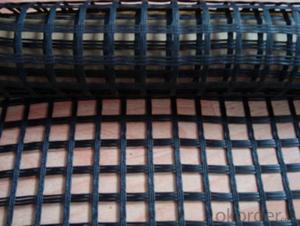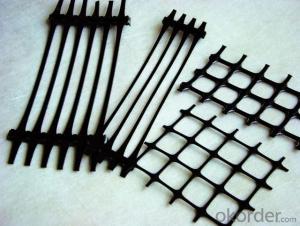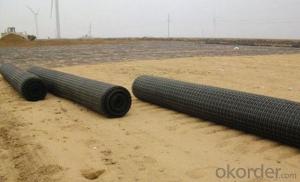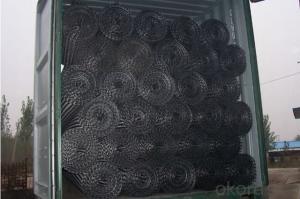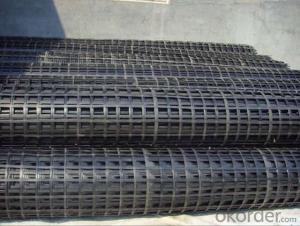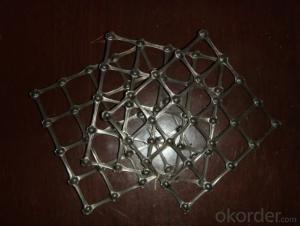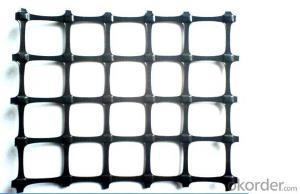Flexible HDPE Uniaxial Geogrid Supplier from China
- Loading Port:
- Qingdao
- Payment Terms:
- TT or L/C
- Min Order Qty:
- 20000 m²
- Supply Capability:
- 10000000 m²/month
OKorder Service Pledge
OKorder Financial Service
You Might Also Like
HDPE Geogrid Introduction
HDPE geogrid a kind of geotechnical material with high strength that uses high molecule polymer as main raw material, adds certain ultraviolet proof and aging resistance agent and makes messy chain shape molecules have directional layout and from linear status by unidirectional extension. Plastic geotechnical grid makes directional tension under certain temperature condition, tension resistance reaches 100-200 MPa, yield elongation rate is only 4%-10%, it is near to the level of low carbon steel and much better than traditional or current reinforcement materials, and is very ideal synthetic material for strengthening and reinforcement of civil projects.
HDPE Geogrid Features
1.High unidirectional tension resistance, good creep resistance and stable chemical nature.
2.hdpe geogrid has large friction factor with sandy stone.
HDPE Geogrid Application Range
1.It is mainly used in retaining wall, bridge abutment, steep slope project and so on.
2.Retaining wall and bridge abutment belong to force bearing structures and bear all external loads such as active soil pressure, support of structure upper part and temperature stress. Under the function of large tension and repeated function of dynamic load, molecule structure of reinforcement material occurs fatigue, its performance occurs attenuation and aging of grid quickens. In order to avoid large deformation of structure caused by creep of reinforcement material, unidirectional geotechnical grid with high-density polyethylene (HDPE) as raw material shall be used.
Fiberglass Geogrid Detail Specifications
Item | 50 | 80 | 120 | 140 | 160 | 170 | 200 |
Vertical Tensile Strength (KN/m) ≥ | 50 | 80 | 120 | 140 | 160 | 170 | 200 |
elongation ration(%)≤ | 11.5 | ||||||
Tensile Strength at 2% elongation (KN/m) ≥ | 12 | 21 | 33 | 38 | 47 | 49 | 58 |
Tensile Strength at 5% elongation (KN/m) ≥ | 23 | 40 | 65 | 75 | 93 | 98 | 115 |
Length (m) | 50 | ||||||
Width (m) | 1.0/1.1 | ||||||
Product Photos


- Q:What kind of experiments need to be done to check geogrid
- Or the same as the first inspection, different places are not the same as the results of some of the equipment testing may be out, but the probability is not. The company specializes in the production of Geogrid
- Q:How to do a good job ah? How to start the sale of geotechnical materials
- First, the product is better, the price is right, good service. Our products sell well.
- Q:How do geogrids help in reducing soil settlement?
- Geogrids help in reducing soil settlement by providing reinforcement to the soil, increasing its stability and preventing excessive movement. They distribute the load over a larger area, improving the overall bearing capacity of the soil and reducing the potential for settlement. Additionally, geogrids can restrict lateral movement of the soil particles, minimizing the chances of settlement and maintaining the integrity of the structure or foundation.
- Q:PVC HF what is the material PVCHF bidirectional geogrid is like?
- General synthetic resin. Depending on the addition of plasticizers, can be divided into two types of hard and soft pvc.
- Q:Can geogrids be used in reinforcement of stormwater management systems?
- Yes, geogrids can be used in the reinforcement of stormwater management systems. Geogrids provide added structural stability and strength to the soil, helping to prevent erosion and maintain the integrity of the stormwater management infrastructure. They are often used in the construction of retaining walls, embankments, and other drainage structures to enhance their resilience and long-term performance.
- Q:Are geogrids suitable for use in soil reinforcement for coastal protection structures?
- Yes, geogrids are suitable for use in soil reinforcement for coastal protection structures. They are commonly used to enhance the stability and strength of soils in coastal areas, providing effective erosion control and protection against wave action and tidal forces. Geogrids help to distribute loads and reinforce the soil, preventing erosion and maintaining the integrity of coastal protection structures.
- Q:Can geogrids be used in railway ballast reinforcement applications?
- Yes, geogrids can be used in railway ballast reinforcement applications. Geogrids provide effective reinforcement to the ballast layer, increasing its strength and stability. By distributing loads more evenly, geogrids help to reduce settlement and deformation, improving the overall performance and longevity of the railway track.
- Q:Can geogrids be used in slope stabilization for mining waste dumps?
- Yes, geogrids can be used in slope stabilization for mining waste dumps. Geogrids are high-strength materials that provide reinforcement and stability to slopes, preventing erosion, soil movement, and potential slope failure. By installing geogrids in mining waste dumps, the slopes can be reinforced, reducing the risk of landslides and ensuring the safety and stability of the dump.
- Q:Can geogrids be installed on steep slopes?
- Yes, geogrids can be installed on steep slopes. Geogrids are commonly used in slope stabilization applications to reinforce the soil and prevent erosion. They provide stability and support to the slopes, even in challenging terrains with steep inclines.
- Q:Can geogrids be used in slope stabilization for railway embankments with high water table conditions?
- Yes, geogrids can be used in slope stabilization for railway embankments with high water table conditions. Geogrids are commonly used in such scenarios to reinforce the soil and prevent slope failure. They can improve the stability of the embankment by increasing the bearing capacity and reducing water infiltration, thus mitigating the adverse effects of high water table conditions.
1. Manufacturer Overview |
|
|---|---|
| Location | Shandong, China |
| Year Established | 2002 |
| Annual Output Value | Above US$ 20 Million |
| Main Markets | 20.00% North America 15.00% South America 15.00% Eastern Europe 10.00% Southeast Asia 10.00% Northern Europe 10.00% South Asia 10.00% Western Europe 5.00% Africa 5.00% Mid East |
| Company Certifications | ISO9001:2000; |
2. Manufacturer Certificates |
|
|---|---|
| a) Certification Name | |
| Range | |
| Reference | |
| Validity Period | |
3. Manufacturer Capability |
|
|---|---|
| a)Trade Capacity | |
| Nearest Port | Qingdao Port |
| Export Percentage | 41% - 50% |
| No.of Employees in Trade Department | 6-10 People |
| Language Spoken: | English; Chinese; |
| b)Factory Information | |
| Factory Size: | Above 80,000 square meters |
| No. of Production Lines | Above 10 |
| Contract Manufacturing | Design Service Offered; Buyer Label Offered |
| Product Price Range | High; Average |
Send your message to us
Flexible HDPE Uniaxial Geogrid Supplier from China
- Loading Port:
- Qingdao
- Payment Terms:
- TT or L/C
- Min Order Qty:
- 20000 m²
- Supply Capability:
- 10000000 m²/month
OKorder Service Pledge
OKorder Financial Service
Similar products
New products
Hot products
Hot Searches
Related keywords
